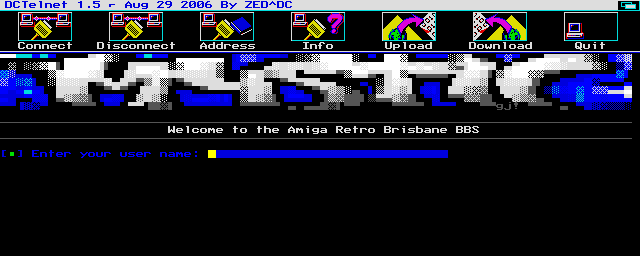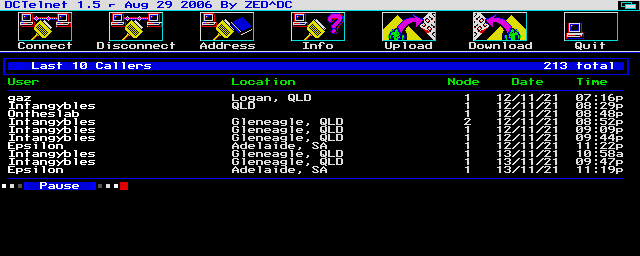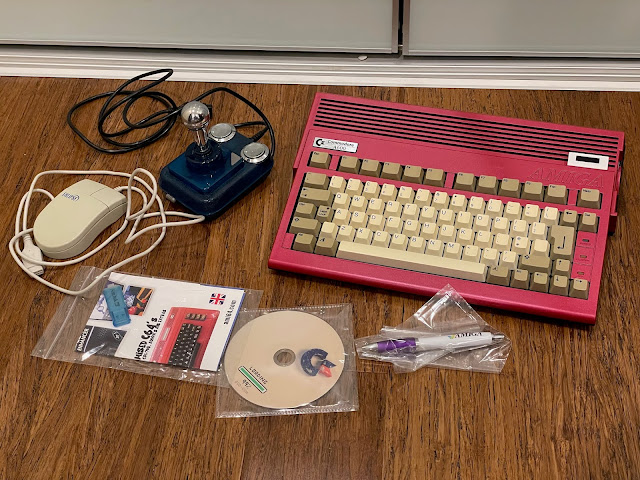No carrier, ATDT, ATZ, ZModem, XModem, Kermit, Door games, FidoNet, and SysOps. Ring a bell?
For those who never got to experience Bulletin Board Systems (BBS) back in the day, they were the pre-internet method for spreading software, chatting, playing online gaming, chatting on Forums, and a lot more too.
In the late 1980's and early 1990's I was heavily using BBS via 2400 baud rate modem on my Amiga 500 and later Amiga 2000 to get new software, chat with other Amiga fans and to play some classic BBS Door games online.
In recent times there has been movement to re-build this method of using computers as part of the "Retro" revival, and so BBS have sprung up using telnet gateways, allowing us to connect to these old BBS systems using the internet.
In 2021, I got back on board with this and bought a Wimodem 232 from CBMstuff.com, which allows you to connect your Amiga via a simulated serial modem, which is actually connected via your local WiFi SSID to the internet. FYI you can also do this with a Commodore 64, which I have demonstrated at Adelaide Retro Group meetings when I ran them in the past.
Here is the WiModem 232 for the Amiga:
It has a screen on it to show the current status of the modem. It needs power via a USB power cable to function.
With the WiModem 232 device connected to the Amiga 3000's serial port with USB power supplied, it is looking for a router and it is time to configure it.
There are plenty of instructions on how to do this online. I don't plan to repeat those here as the
guides online at cbmstuff.com are good enough to get anyone online, even me. I chose to use NComm 3.0 initially for this, as it is the terminal program I am most familiar with using on the Amiga.
Running the command ATI in NComm shows the current configuration of the WiModem:

For privacy reasons I can't show the full WiModem 232 setup as it reveals a lot of my personal network setup which I don't want to disclose - sorry about that. Basically it scans for local SSID's and you issue some Hayes commands into the terminal program to select the network you want to use, and the password. This is then saved into the memory of the WiModem and it connects automatically the next time it is switched on.
Initially the modem is set to 300 baud. I chose to change it to 19200. You can use higher speeds of course, but higher speeds like 56k and 115k on the serial port does start to impact the Amiga's performance the higher you go, unless you have Zorro interface card with buffered serial interfaces. Keeping the speed reasonable allows me to listen to my favourite modules and do other tasks on the Amiga while the BBS session is running.
Some friends of mine from the Brisbane Amiga Retro Group (which
I visited and did a presentation in 2019), recently decided to create their own BBS too, using Mystic BBS software running 24x7 on a hosted linux server, available via amigaretro.com on port 23.
You could run a BBS solution on your Amiga of course, but it is a lot more work, and also means keeping your beloved Amiga running 24x7, reducing it's operating life considerably! So it is hosted for simplicity and to safeguard our Amigas!
So I quickly connected to amigaretro.com port 23 to try it out!
As you can see, NComm is not using ANSI support, so the output is a bit rubbish.
I setup my user account on the BBS:
I got the welcome email from the SysOp and responded to become a full member of the site.
It is kind of fun to add your own one liner when you log in, a tradition in BBS land that still continues on demoscene focused
pouet.net today!
That done, I checked the files area:
I had read through Brisbane Amiga Retro Group's Discord page that one of the members had great success using DCTelnet on the Amiga for BBS use, which relies on having working network and internet access from your Amiga, rather than using a device like WiModem 232.
Luckily, I do have this via my X-Surf 100 card and purchased version of Roadshow TCP software on the Amiga 3000.
Members had already put the required files on the BBS, so I could easily get what I needed on the BBS without having to go anywhere else!
Flagged for download..
Downloading files via Modem and Modem - really brings back so many fond memories.
Disconnecting, installing DCTelnet, copying the fonts to the FONTS: directory and switching from NComm to DCTelnet, I got a very different (and more normal) ANSI BBS experience on my Amiga 3000.
I configured my Address book to add AmigaRetro.com port 23, and added my username and password, which I can pass into the system on connection using Amiga-N and Amiga-P shortcuts.
I then connected to the BBS. Now THIS is more like it:
My favourite Mods playing on the Amiga 3000 in the background, and BBS access all areas in 2021. Oh yeah!
With the SCSI CDROM connected, I could also enjoy Lizardking's greatest hits CD on the Amiga 3000 while using the BBS via DCTelnet.
Moving back to DCTelnet, the Amigaretro.com BBS and into the main menu again, it is now looking a million times better than in Ncomm with full ANSI support.
Intangybles, the handle of the guy who built this new BBS, was online and we soon engaged in a great chat about all things BBS and Amiga, just like it was 1990 all over again!
I can't begin to tell you how many strong memories came from just this first night on a BBS in over 25 years!
Naturally I was keen to explore more, and Intangybles was also keen to expand the functionality of the BBS, enabling forums and network access to send messages across other networks.
I had a snoop around to see who else had been online, and if anyone was around.
Usage patterns - being a brand new BBS, of course not so many as yet, but I expect as more functionality and games are added to the BBS we should see more coming from all over the world. Hopefully I get to see some of you reading this online here soon!
Also, Door games are being added to the BBS. I personally used to play BBS Crash almost everyday, and was very keen to try it again. I located it and waited for the SysOp to work his magic to get it working.
One of the challenges with this is that most games required registration, and the original source code and authors have long ago given up on the software, which makes it hard to get registered versions to use. Some sites like BBSFiles.com are helping with this, trying to save s many BBS door games as possible for future generations to experience and enjoy.
Speaking of these games, I had a go at Blackjack, since it was already online on the BBS, ready to try out.
I admit I am pretty awful at card games like this, and so it proved! I did win occasionally, but soon ran out of virtual money to play with! This is why I never go to Casinos!
I also tried out the Stack 'Em door game available on the BBS, and had a lot of fun playing this Tetris clone!
It never ceases to amaze me how playable a text graphics based game can be on a BBS.
I got sucked in and ended playing it for over 30 minutes!
Exploring the forums available through the BBS is fun too. I know these days we can use web forums, Discord, Facebook and other online tools too, but these kinds of local and network forums were genesis, where it all began. They are still active today too, like fsxnet:
I also got some more files that were online on the BBS.
Scroll down the list, and press space on any file you want to tag it for download.
Using the internet to download files via ZModem is of course a much faster way to do it than the original Modem on a real modem...In the old days I would start it and go off to do something else while the file(s) downloaded very slowly to my computer.
Not long after this Intangybles came through with a working install (unregistered) of my favourite BBS door game - BBS Crash. I was so excited to play it again after so many years, albeit limited due to not being able to save progress to play it daily as you need to.
I quickly got to work, and the game started coming back to me, keeping my disk space, uploading trojans, trashing BBS files to gain levels, money from hacking SysOp's bank accounts and improving your experience.
Start at BBS number 1 and work your way up.
If the SysOp catches you, things go bad fast. If you run out of disk space trying to trash the BBS, it's game over.
You can retry a few times per day, and regularly free up your initial 10MB space to work with to trap and backup your data gained from destroying other BBS systems. Levelling up with limited tries per day is the hook to keep you coming back everyday to try again!
You have to drop carrier and empty often to avoid running out of disk space. If you run out of disk space it is game over.
Checking my status reveals I have a long way to go:
Back in the day I was hooked on this game, and would dial up to my local BBS to play it every day.
I hope I have brought across how much fun playing with a BBS again in 2021 really is. Please try it out when you can, it is a lot of fun and I guarantee if you used BBS in the past, the memories will come flooding back in a good way! I'll see you on amigaretro.com:23 BBS hopefully soon!





















































































